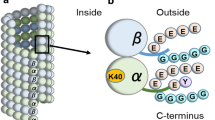Summary
The cellular distributions of tubulin and microtubule-associated protein 2 (MAP2) were examined in the dentate gyrus of the rat hippocampus after unilateral lesion of the entorhinal cortex, which destroys the major afferent pathway to dentate granule cells. Changes were observed in distribution of both tubulin and MAP2 in granule cell dendrites on the denervated side. After 24h there was a noticeable increase in both anti-tubulin and anti-MAP2 staining in the outer two-thirds of the dentate molecular layer, corresponding to the area of denervation. This increased staining reached a maximum 1 week after the lesion. There was no change on the unlesioned side. During a subsequent second phase the region of increased anti-tubulin and anti-MAP2 staining became restricted, by 35 days after lesioning, to a narrow band mid-way through the molecular layer. This pattern remained the same until 6 months after the lesion, the longest time point examined. The results indicate that there is considerable plasticity in the microtubular cytoskeleton of dendrites in the adult brain and that rearrangements induced in it by axotomy can persist long after the immediate effects of denervation and subsequent re-innervation have subsided.
Similar content being viewed by others
References
BERNHARDT, R., HUBER, G. & MATUS, A. (1984) Differences in the developmental patterns of three microtubule-associated proteins in brain.Journal of Neuroscience 5, 977–91.
BERNHARDT, R. & MATUS, A. (1984) Light and electron microscopic studies of the distribution of microtubule-associated protein 2 in rat brain: a difference between the dendritic and axonal cytoskeletons.Journal of Comparative Neurology 226, 203–21.
BRAY, D., THOMAS, C. & SHAW, G. (1978) Growth cone formation in cultures of sensory neurons.Proceedings of the National Academy of Sciences USA 81, 5626–9.
CACERES, A. & DOTTI, C. (1985) Immunocytochemical localization of tubulin and the high molecular weight microtubules-associated protein MAP2 in Purkinje cells deprived of climbing fibres.Neuroscience 16, 133–50.
CACERES, A. & STEWARD, O. (1983) Dendritic reorganization in the denervated dentate gyrus of the rat following entorhinal cortical lesions: a Golgi and electron microscopic analysis.Journal of Comparative Neurology 214, 387–403.
De CAMILLI, P., MILLER, P. E., NAVONE, F., THEURKAUF, W. E. & VALLEE, R. B. (1984) Distribution of microtubule-associated protein 2 in the nervous system of the rat studied by immunofluorescence.Neuroscience 11, 817–46.
HUBER, G. & MATUS, A. (1984) Differences in the cellular distributions of two microtubule-associated proteins, MAP1 and MAP2, in rat brain.Journal of Neuroscience 4, 151–60.
LOESCHE, J. & STEWARD, O. (1977) Behavioral correlates of denervation and reinnervation of the hippocampal formation of the rat: recovery of alternation performance following unilateral entorhinal cortex lesion.Brain Research Bulletin 2, 31–9.
LYNCH, G., MATTHEWS, D. A., MOSKO, S., PARKS, T. & COTMAN, C. W. (1972) Induced acetylcholinesteraserich layer in rat dentate gyrus following entorhinal lesions.Brain Research 42, 311–18.
LYNCH, G., MOSKO, S., PARKS, T. & COTMAN, C. W. (1973) Relocation and hyperdevelopment of the dentate gyrus commissural system after entorhinal lesions in immature rats.Brain Research 50, 174–9.
MATUS, A., BERNHARDT, R., BODMER, R. & ALAIMO, D. (1986) Microtubule-associated protein 2 and tubulin are differently distributed in the dendrites of developing neurons.Neuroscience 17, 371–89.
MATUS, A. & RIEDERER, B. (1986) Microtubule-associated proteins in the developing brain.Annals of the New York Academy of Sciences 466, 167–79.
NUNEZ, J. (1986) Differential expression of microtubule components during brain development.Developmental Neuroscience 8, 125–41.
RIEDERER, B. & MATUS, A. (1985) Differential expression of distinct microtubule-associated proteins during brain development.Proceedings of the National Academy of Sciences USA 82, 6006–9.
SEEDS, N. W., GILMAN, A. G., AMANO, T. & NIRENBERG, M. W. (1970) Regulation of axon formation by clonal lines of a neuronal tumor.Proceedings of the National Academy of Sciences USA 60, 160–7.
STEWARD, O. (1986) Lesion-induced synapse growth in the hippocampus. InThe Hippocampus, Vol. 3 (edited by ISAACSON, R. L. & PRIBRAM, K. H.), pp. 65–111. New York: Plenum Press.
STEWARD, O., COTMAN, C. W. & LYNCH, G. S. (1973) Re-establishment of electrophysiologically functional entorhinal cortical input to the dentate gyrus deafferented by ipsilateral entorhinal lesions: innervation by the contralateral entorhinal cortex.Experimental Brain Research 18, 396–414.
Author information
Authors and Affiliations
Rights and permissions
About this article
Cite this article
Kwak, S., Matus, A. Denervation induces long-lasting changes in the distribution of microtubule proteins in hippocampal neurons. J Neurocytol 17, 189–195 (1988). https://doi.org/10.1007/BF01674206
Received:
Accepted:
Issue Date:
DOI: https://doi.org/10.1007/BF01674206




